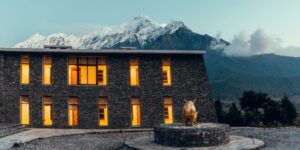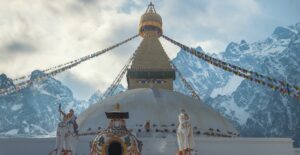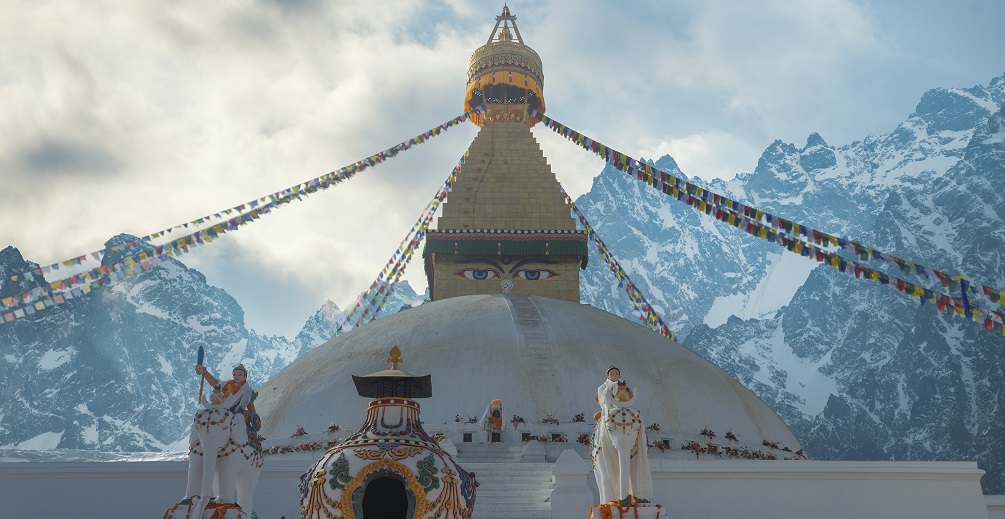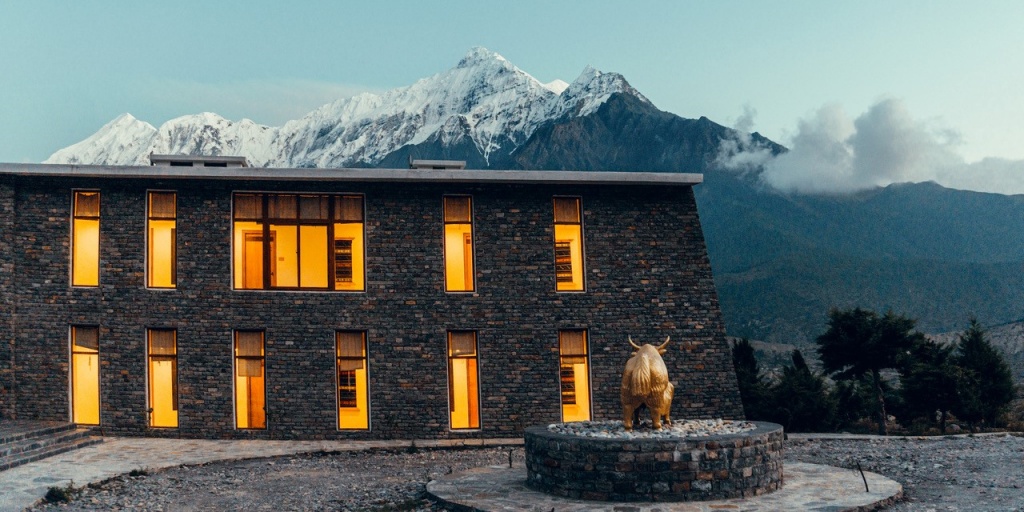Nepal
Trek some of the world’s steepest snow-covered peaks and explore the wide variety of delicious cuisines Nepal offers.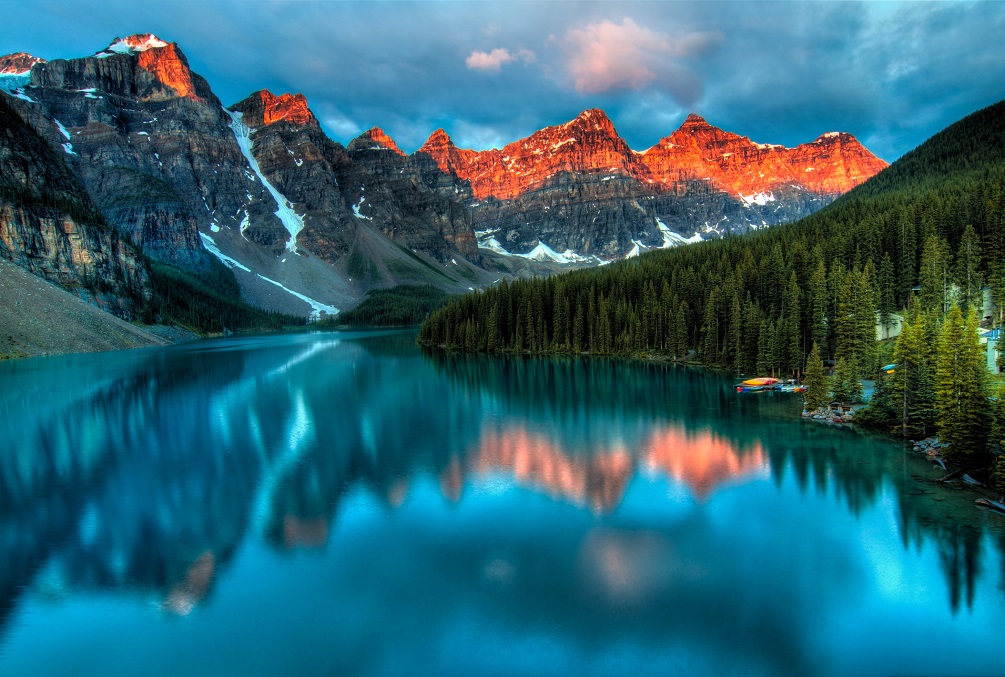
Residing in the foothills of the Himalayas, Nepal is a South Asian country known for its rugged landscape and steep mountain ranges.
Eight of the world’s highest peaks lie in Nepal, one of which is Mount Everest, which is also the tallest mountain in the world.
Although Nepal is a small country, it’s home to over 100 ethnic groups. Most of the population lives in the capital, Kathmandu.
Kathmandu is the cultural and economic heart of the country, where one can explore glittering temples and UNESCO World Heritage sites.
A great way to learn about Nepal is through the food of its people. You can sample five different cuisines in the country, including Janajati in the middle hills and Thakali from the Himalayan lowlands.
Nepali is the language spoken in Nepal. It’s one of the world’s oldest languages and it has several dialects.
Most of Nepal’s population adheres to Hinduism.
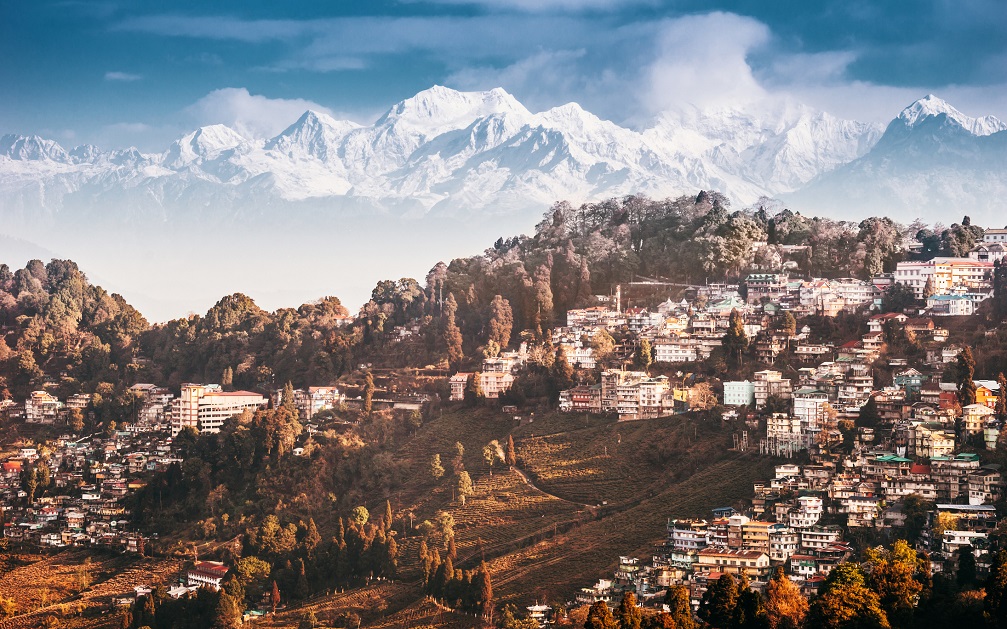


Nepal is in South Asia between China in the north and India in the south, east, and west.
The country includes part of the Indo-Gangetic plain and it has the rockiest terrain in the world. About 75 percent of the landscape is mountainous, with most ranges belonging to the Himalayas.
The highest point is Mount Everest (8,848 m) followed by Kanchenjunga (8,586 m), Lhotse (8,516 m), Makalu (8,463 m), Cho Oyu (8,201m), Dhaulagiri (8,167 m), Manaslu (8,163 m), and Annapurna (8,091 m).
The Tarai (60 m) of Kechana Kalan in Jhapa is the lowest point.
There are three main geographical areas extending from east to west: the plains (Tarai), hills (Pahaad), and mountains (Himal).
The Tarai is low-lying, fertile land neighboring the Indian border. These plains form the northern rim of the Gangetic plain and they contain some hill ranges. The southern parts hold the agricultural land while the north is marshland.
The inner Tarai zone and a sparsely populated region, known as the Churia Range, give way to the Mahabharat Range to the north.
The midland, where the Kathmandu and Pokhara valleys lie, is north of the Mahabharat Range. These valleys are flat basins previously covered by lakes.
The Great Himalaya Range lies to the north, next to China’s border. It contains the world’s highest peaks, including Mount Everest.
A few scattered settlements can be found in the high mountain valleys of the Himalayas. Otherwise, this region is uninhabited.
Nepal has 6,000 snow-fed or rain-dependent rivers. Three permanent rivers feed into the Tarai: the Koshi, the Narayani, and the Karnali.
There are over 30 natural caves in Nepal. One of these is Maratika Cave, also known as Haleshi, which is a pilgrimage site associated with both Buddhism and Hinduism.
Some caves in Pohkara include Bats’ shed (Mahendra Gufa), Gupteswar, Patale Chhango, and Batulechar.
The Luri and Tashi Kabum caverns, near Lo Manthang in Mustang, house 13th-century old murals.
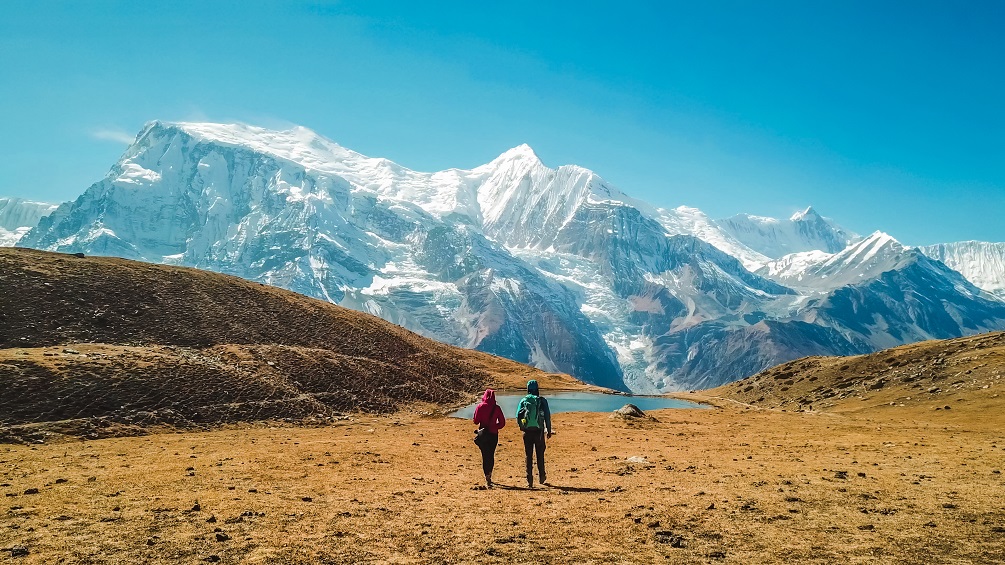


Nepal has five climate zones owing to the varying altitude of its landscape.
The Tarai regions have tropical and subtropical weather.
The mid-mountain region between 1,200 to 2,400 metres (3,900 to 7,900 ft.) has a warm temperate climate.
In the higher parts of the mountains between 2,200 to 3,400 metres (7,000 and 11,000 ft.), conditions are cool temperate.
Between 4,300 and 4,900 metres (14,000 and 16,000 ft.), along the lower slopes of the Himalaya Mountains, the climate is subarctic.
And the areas above 4,900 metres (16,000 ft.) have an arctic climate. Temperatures never rise below freezing and snow and ice always cover the ground.
Much like the climate, Nepal experiences five seasons: summer, monsoon, autumn, winter, and spring.
The average temperatures in the Kathmandu valley range from 10 °C (50 °F) in January to 26 °C (78 °F) in July.
The eastern regions of the Tarai receive the most rainfall (70 to 75 inches [1,800 to 1,900 mm] a year at Bīratnagar), while the west is often drier.
The average rainfall in the Kathmandu Valley is roughly 55 inches (1,400 mm). Most precipitation falls from June to September.
The temperatures at Pokhara range from 4 °C (40 °F) in January to about 38 °C (100 °F) in June. Winters are pleasantly warm, with daytime temperatures rising to 21 °C (70 °F). Nights in this region are cool, but not cold.
The Pokhara Valley receives the most rain (around 100 inches [2,500 mm]) due to warm rain-bearing monsoon winds releasing the bulk of their moisture as they approach the Annapurna Mountain.
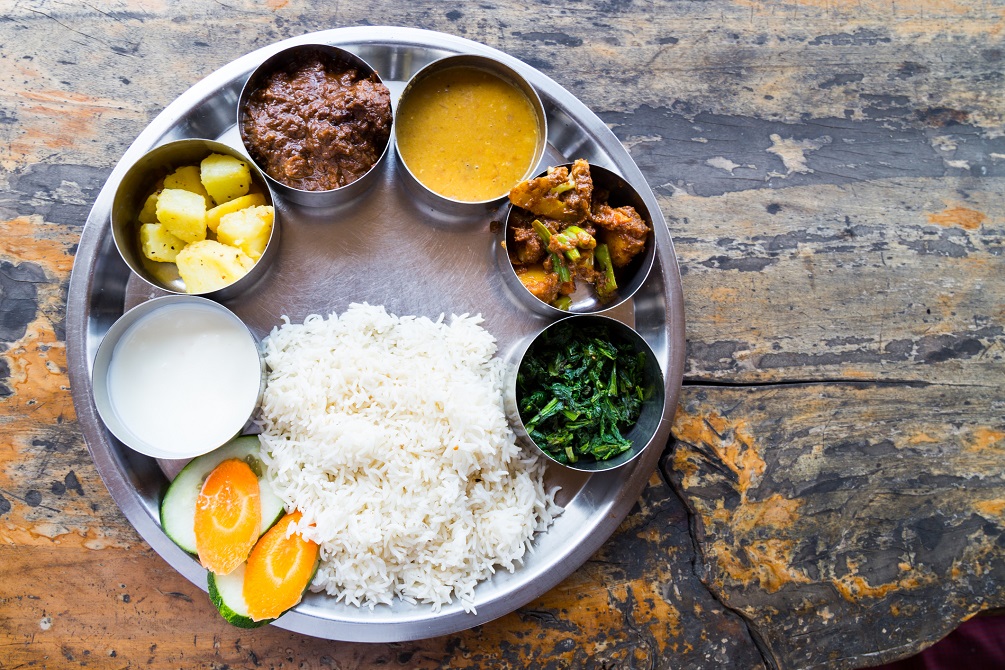


From potato yoghurt salad to momos, a world of flavours awaits in Nepal.
The cuisine of Nepali people varies substantially from region to region because of the diversity in soil type, ethnic groups, culture, and climate. Therefore, Nepali cuisine isn’t defined by a single cooking style or a combination of specific ingredients.
The five types of cuisines you can sample in Nepal include:
- Urbanized Newari cuisine from Kathmandu Valley
- Thakali cuisine from the Himalayan lowlands
- Madhesi, comprising Maithili, Bhojpuri, Awadhi and Lohorung, indigenous to the Eastern Nepal region
- Himalayan cuisine, culturally close to Trans Himalayan and Tibetan ethnic groups
- Janajati cuisine in the middle hills
Indian and Tibetan cooking techniques have influenced Nepali cuisine.
Rice is a key component of many meals, eaten twice a day by Nepali people. Other meal staples include potatoes, cashews, peanuts, tomatoes, pineapples, guavas, and chilli peppers.
Jimbu, a dried Himalayan herb, is often used to add flavour to dishes or as garnish. Chhyapi (Shallots) are also regularly used in meals. Some other common herbs and flavourings include Jwanu and Chuk (lemon concentrate).
You can enjoy authentic Nepali food in Newari at one of many eateries.
Some dishes you must try are momo (meat or vegetable dumplings steamed, fried or included in a soup) and Dhal Bhat (a staple Nepali meal made of dal, rice, vegetable, and sauce). Tama, a vegetarian Nepali dish served as a soup, curry, or stew, is also worth the try.
Popular savoury snacks include Wo (or Bara), a pancake or patty made from spiced lentils and Chatamari (or Newari Pizza), a crepe topped with minced meat, eggs with onions and spices.
Some sweet snacks you should try are Juju dhau (traditional yoghurt made from buffalo milk), Lapsi (or Nepali Hog Plum, a wild fruit native to Nepal) and Yomari (a steamed dumpling filled with chaku made from rice flour).
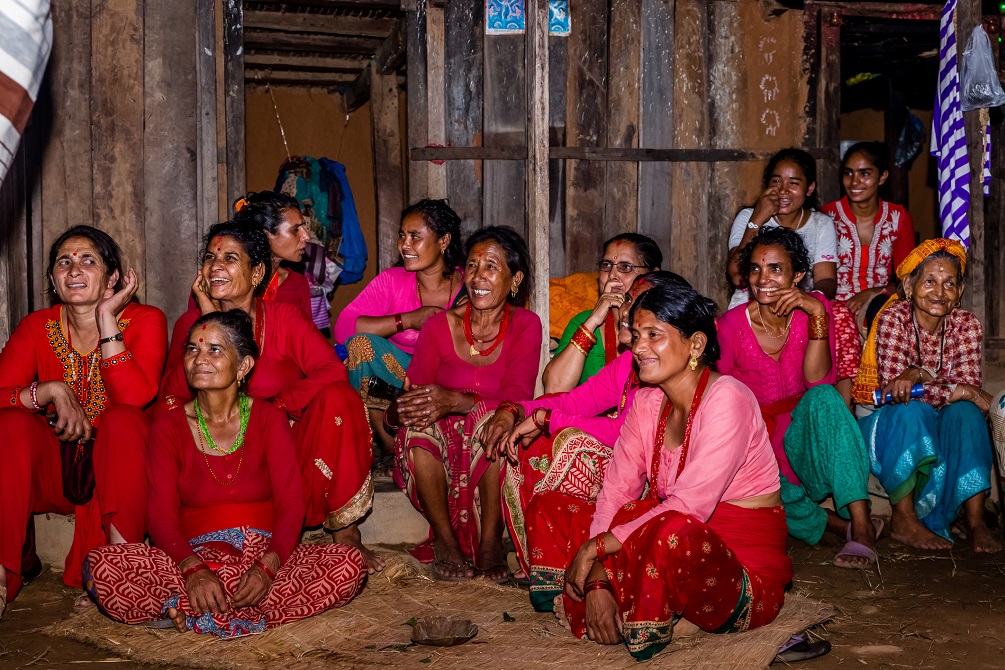


A long cotton shirt worn over matching leggings (known as a sari or kurta) is the traditional dress for many Nepali women. However, in the cities, young Nepali women wear Western-style clothes.
Elephant pants are the best choice for many travelers when exploring the cities and casual tops that reach the wrists.
When going trekking in Nepal, the climate will differ with changes in altitude. Therefore, light and warm clothing that you can layer is best. You should also bring along a wind- and waterproof jacket.
Walking boots with ankle support are ideal for trekking. The second pair of comfortable shoes will come in handy as well if you get blisters on the way.
Nepal is a conservative and deeply religious country, so make sure everything you pack covers your shoulders.
Dressing appropriately will allow you to explore ancient ruins, temples, and the UNESCO World Heritage sites with no issues.
For a spring trip to Nepal that doesn’t involve trekking, pack clothes for warm weather that covers your shoulders and knees.
If you’re visiting for the Holi festival in March, bring garments you don’t mind being stained with color.
Summers in Nepal is hot, so light, breathable clothing is best. During monsoon season, an umbrella will work better than a rain jacket. Flip-flops and trekking sandals are also best over closed shoes.
A light jacket, cardigan, or pashmina is a must-have for an autumn vacation since it gets chilly during the day and at night.
Winters are cold, especially in the mountains. Bring along clothes you can layer because it can be warm during the day.
Remember, it’s always best to check the weather before you travel. That way, you’ll know what to pack.
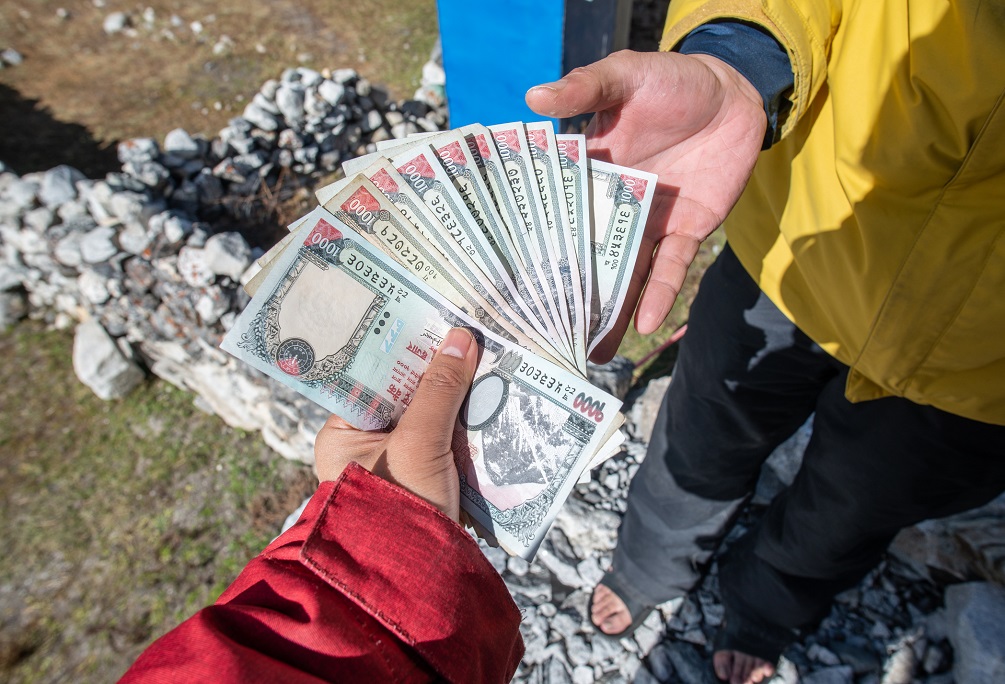


The official currency of Nepal is the Nepalese rupee (NPR). One Nepalese rupee is split into 100 paisa.
Bank notes come in denominations of Rs1000, 500, 100, 50, 20, 10, 5, 2, and 1. Coins come in denominations of 50, 25, and 10 paisa.
Banks, hotels, and licensed moneychangers are all places where you can exchange your foreign currency for the local currency.
MasterCard and Visa are the most widely accepted cards at restaurants, tourist shops, hotels, and travel agencies.
ATMs are common in Nepal except in the mountains. If you’re trekking, ensure you take enough cash for the trip.
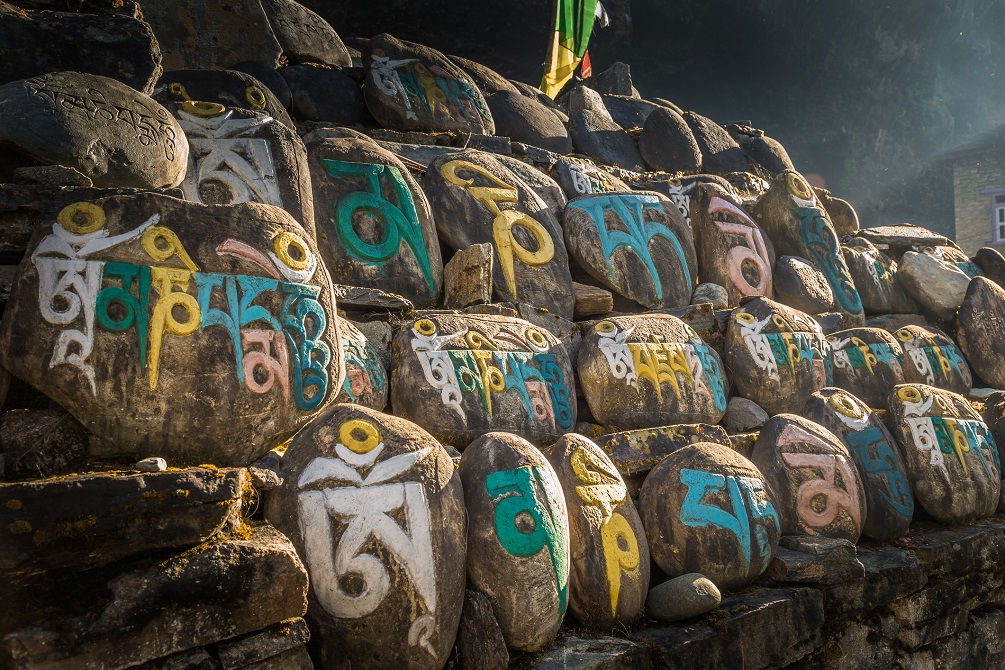


Nepali is the main and official language of Nepal. It serves as a lingua franca among the different ethnic groups.
There are several regional dialects of Nepali spoken in the Tarai and mountain regions.
Other languages spoken in the country include Maithili in the southern Tarai region, Tharu, and Urdu by Nepali Muslims. And there are at least four indigenous sign languages in Nepal.
English is the second language of over 30% of the population.
It’s more like you’ll find English speakers in Kathmandu compared to other parts of Nepal, so you might not have any issues navigating the city. However, as you venture beyond the urban centers, you may need to know the local language to get by.
These are some common Nepali words and phrases with their pronunciations to use during your trip:
- Hello – Namaste (Na-mas-tay)
- Goodbye – Alavidā (Al-vi-da)
- Excuse me/sorry – Māpha garnuhōs (Maff Gar-nuu-hos)
- Thank you – Dhanyabād (Dan-yah-bad)
- Welcome – Namaste
- Yes – Hō
- No – Hō’īna (Hō’ī-na)
- How much is it? – Kati Paisa? or Kati ho?
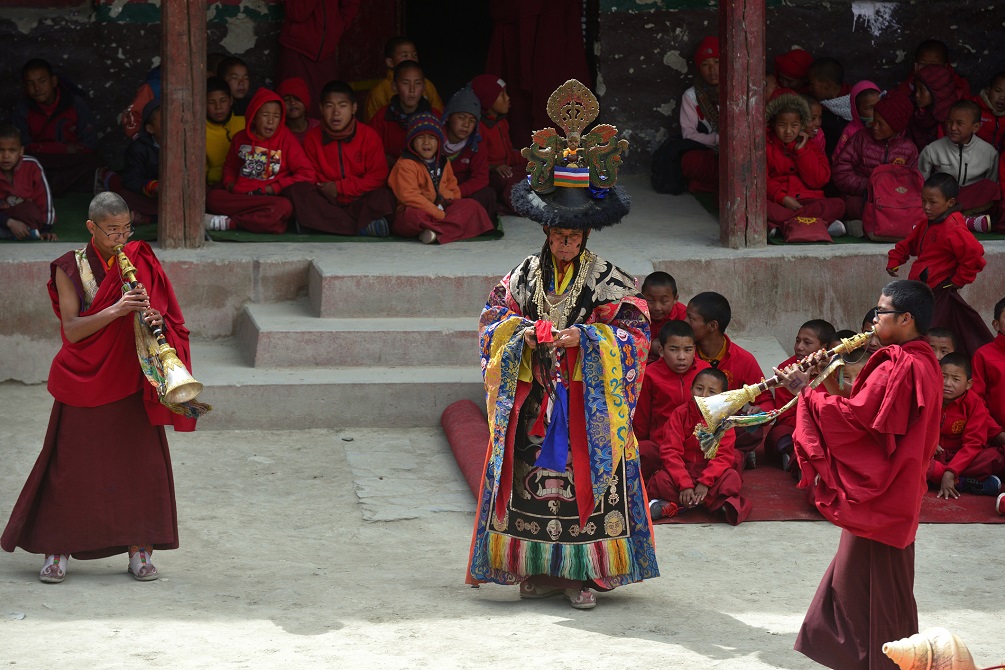


Nepal is home to about 125 ethnic groups, all with their own culture and traditions, language, cuisine, and traditional dress.
Nepalis are descendants of migrant Asian groups from India, Tibet and Burma, and the Chinese province of Yunnan.
Some of the earliest inhabitants of the country are the Kirat, Newar, Tharu, and the Khas Pahrai.
The Newar bears significant influence in Nepal, especially in the Kathmandu valley. They have contributed sculptures, paintings, and architecture to Nepal’s cultural heritage. Around 2,500 temples and shrines display the Newar artists’ talent and refined aesthetic sense.
Most of the population is Hindu, while a small portion adheres to other religions, like Buddhism and Islam.
One of the greatest poets who contributed to Nepali literature, and the rest of the world, is Laxmi Prasad Devkota.
Music and dance are popular pastimes among Nepalis, and they place a high priority on family values.
Many of the festivals that occur in Nepal are religious celebrations. These include Tihar, Holi, Eid ul-Fitr, Christmas, and the Nepali New Year (13 or 14 April). Holi is a festival held during March where people through color and water at each other.
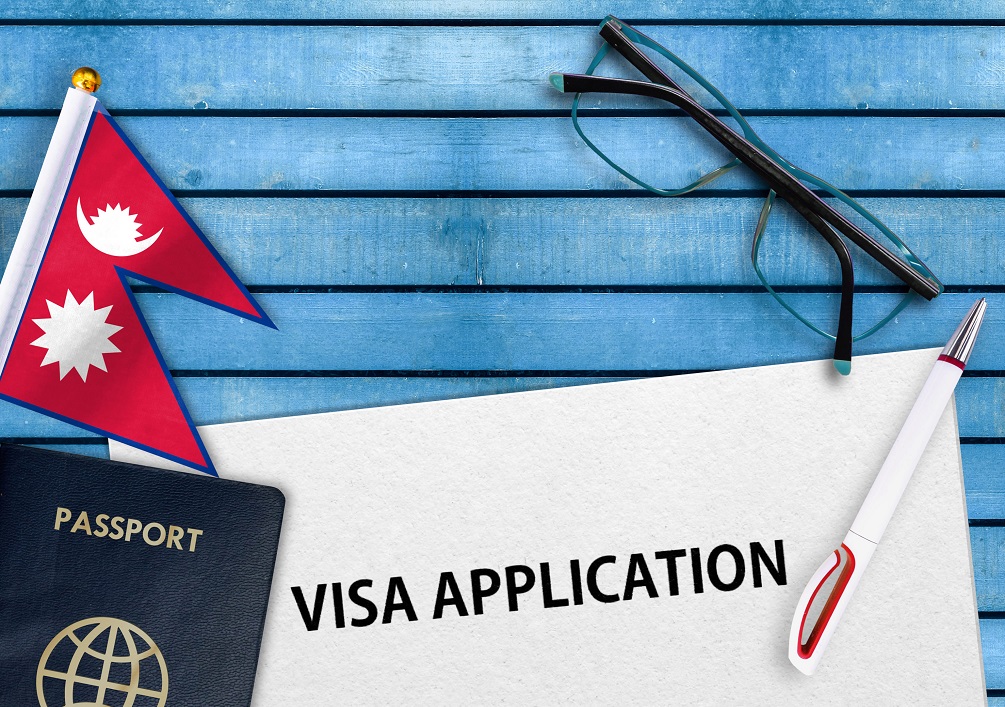


British citizens don’t need to apply for a visa before traveling to Nepal. You’ll be issued a visa on arrival that may be valid for up to 90 days.
When you apply for a visa, your passport must be valid for at least six months.
Ensure you don’t overstay your visa. If you do, you can face a significant fine and possible imprisonment.



There are three types of plugs and sockets in Nepal: Type C (flat with two round pins), Type D (triangular with three round pins in a triangular pattern), and Type M (three round pins).
The sockets supply a standard voltage of 230 V and a standard frequency of 50 Hz.
Ensure you bring along a transformer for devices and appliances with a lower voltage and a universal adapter with surge protection.



Residing in the foothills of the Himalayas, Nepal is a South Asian country known for its rugged landscape and steep mountain ranges.
Eight of the world’s highest peaks lie in Nepal, one of which is Mount Everest, which is also the tallest mountain in the world.
Although Nepal is a small country, it’s home to over 100 ethnic groups. Most of the population lives in the capital, Kathmandu.
Kathmandu is the cultural and economic heart of the country, where one can explore glittering temples and UNESCO World Heritage sites.
A great way to learn about Nepal is through the food of its people. You can sample five different cuisines in the country, including Janajati in the middle hills and Thakali from the Himalayan lowlands.
Nepali is the language spoken in Nepal. It’s one of the world’s oldest languages and it has several dialects.
Most of Nepal’s population adheres to Hinduism.



Nepal is in South Asia between China in the north and India in the south, east, and west.
The country includes part of the Indo-Gangetic plain and it has the rockiest terrain in the world. About 75 percent of the landscape is mountainous, with most ranges belonging to the Himalayas.
The highest point is Mount Everest (8,848 m) followed by Kanchenjunga (8,586 m), Lhotse (8,516 m), Makalu (8,463 m), Cho Oyu (8,201m), Dhaulagiri (8,167 m), Manaslu (8,163 m), and Annapurna (8,091 m).
The Tarai (60 m) of Kechana Kalan in Jhapa is the lowest point.
There are three main geographical areas extending from east to west: the plains (Tarai), hills (Pahaad), and mountains (Himal).
The Tarai is low-lying, fertile land neighboring the Indian border. These plains form the northern rim of the Gangetic plain and they contain some hill ranges. The southern parts hold the agricultural land while the north is marshland.
The inner Tarai zone and a sparsely populated region, known as the Churia Range, give way to the Mahabharat Range to the north.
The midland, where the Kathmandu and Pokhara valleys lie, is north of the Mahabharat Range. These valleys are flat basins previously covered by lakes.
The Great Himalaya Range lies to the north, next to China’s border. It contains the world’s highest peaks, including Mount Everest.
A few scattered settlements can be found in the high mountain valleys of the Himalayas. Otherwise, this region is uninhabited.
Nepal has 6,000 snow-fed or rain-dependent rivers. Three permanent rivers feed into the Tarai: the Koshi, the Narayani, and the Karnali.
There are over 30 natural caves in Nepal. One of these is Maratika Cave, also known as Haleshi, which is a pilgrimage site associated with both Buddhism and Hinduism.
Some caves in Pohkara include Bats’ shed (Mahendra Gufa), Gupteswar, Patale Chhango, and Batulechar.
The Luri and Tashi Kabum caverns, near Lo Manthang in Mustang, house 13th-century old murals.



Nepal has five climate zones owing to the varying altitude of its landscape.
The Tarai regions have tropical and subtropical weather.
The mid-mountain region between 1,200 to 2,400 metres (3,900 to 7,900 ft.) has a warm temperate climate.
In the higher parts of the mountains between 2,200 to 3,400 metres (7,000 and 11,000 ft.), conditions are cool temperate.
Between 4,300 and 4,900 metres (14,000 and 16,000 ft.), along the lower slopes of the Himalaya Mountains, the climate is subarctic.
And the areas above 4,900 metres (16,000 ft.) have an arctic climate. Temperatures never rise below freezing and snow and ice always cover the ground.
Much like the climate, Nepal experiences five seasons: summer, monsoon, autumn, winter, and spring.
The average temperatures in the Kathmandu valley range from 10 °C (50 °F) in January to 26 °C (78 °F) in July.
The eastern regions of the Tarai receive the most rainfall (70 to 75 inches [1,800 to 1,900 mm] a year at Bīratnagar), while the west is often drier.
The average rainfall in the Kathmandu Valley is roughly 55 inches (1,400 mm). Most precipitation falls from June to September.
The temperatures at Pokhara range from 4 °C (40 °F) in January to about 38 °C (100 °F) in June. Winters are pleasantly warm, with daytime temperatures rising to 21 °C (70 °F). Nights in this region are cool, but not cold.
The Pokhara Valley receives the most rain (around 100 inches [2,500 mm]) due to warm rain-bearing monsoon winds releasing the bulk of their moisture as they approach the Annapurna Mountain.



From potato yoghurt salad to momos, a world of flavours awaits in Nepal.
The cuisine of Nepali people varies substantially from region to region because of the diversity in soil type, ethnic groups, culture, and climate. Therefore, Nepali cuisine isn’t defined by a single cooking style or a combination of specific ingredients.
The five types of cuisines you can sample in Nepal include:
- Urbanized Newari cuisine from Kathmandu Valley
- Thakali cuisine from the Himalayan lowlands
- Madhesi, comprising Maithili, Bhojpuri, Awadhi and Lohorung, indigenous to the Eastern Nepal region
- Himalayan cuisine, culturally close to Trans Himalayan and Tibetan ethnic groups
- Janajati cuisine in the middle hills
Indian and Tibetan cooking techniques have influenced Nepali cuisine.
Rice is a key component of many meals, eaten twice a day by Nepali people. Other meal staples include potatoes, cashews, peanuts, tomatoes, pineapples, guavas, and chilli peppers.
Jimbu, a dried Himalayan herb, is often used to add flavour to dishes or as garnish. Chhyapi (Shallots) are also regularly used in meals. Some other common herbs and flavourings include Jwanu and Chuk (lemon concentrate).
You can enjoy authentic Nepali food in Newari at one of many eateries.
Some dishes you must try are momo (meat or vegetable dumplings steamed, fried or included in a soup) and Dhal Bhat (a staple Nepali meal made of dal, rice, vegetable, and sauce). Tama, a vegetarian Nepali dish served as a soup, curry, or stew, is also worth the try.
Popular savoury snacks include Wo (or Bara), a pancake or patty made from spiced lentils and Chatamari (or Newari Pizza), a crepe topped with minced meat, eggs with onions and spices.
Some sweet snacks you should try are Juju dhau (traditional yoghurt made from buffalo milk), Lapsi (or Nepali Hog Plum, a wild fruit native to Nepal) and Yomari (a steamed dumpling filled with chaku made from rice flour).



A long cotton shirt worn over matching leggings (known as a sari or kurta) is the traditional dress for many Nepali women. However, in the cities, young Nepali women wear Western-style clothes.
Elephant pants are the best choice for many travelers when exploring the cities and casual tops that reach the wrists.
When going trekking in Nepal, the climate will differ with changes in altitude. Therefore, light and warm clothing that you can layer is best. You should also bring along a wind- and waterproof jacket.
Walking boots with ankle support are ideal for trekking. The second pair of comfortable shoes will come in handy as well if you get blisters on the way.
Nepal is a conservative and deeply religious country, so make sure everything you pack covers your shoulders.
Dressing appropriately will allow you to explore ancient ruins, temples, and the UNESCO World Heritage sites with no issues.
For a spring trip to Nepal that doesn’t involve trekking, pack clothes for warm weather that covers your shoulders and knees.
If you’re visiting for the Holi festival in March, bring garments you don’t mind being stained with color.
Summers in Nepal is hot, so light, breathable clothing is best. During monsoon season, an umbrella will work better than a rain jacket. Flip-flops and trekking sandals are also best over closed shoes.
A light jacket, cardigan, or pashmina is a must-have for an autumn vacation since it gets chilly during the day and at night.
Winters are cold, especially in the mountains. Bring along clothes you can layer because it can be warm during the day.
Remember, it’s always best to check the weather before you travel. That way, you’ll know what to pack.



The official currency of Nepal is the Nepalese rupee (NPR). One Nepalese rupee is split into 100 paisa.
Bank notes come in denominations of Rs1000, 500, 100, 50, 20, 10, 5, 2, and 1. Coins come in denominations of 50, 25, and 10 paisa.
Banks, hotels, and licensed moneychangers are all places where you can exchange your foreign currency for the local currency.
MasterCard and Visa are the most widely accepted cards at restaurants, tourist shops, hotels, and travel agencies.
ATMs are common in Nepal except in the mountains. If you’re trekking, ensure you take enough cash for the trip.



Nepali is the main and official language of Nepal. It serves as a lingua franca among the different ethnic groups.
There are several regional dialects of Nepali spoken in the Tarai and mountain regions.
Other languages spoken in the country include Maithili in the southern Tarai region, Tharu, and Urdu by Nepali Muslims. And there are at least four indigenous sign languages in Nepal.
English is the second language of over 30% of the population.
It’s more like you’ll find English speakers in Kathmandu compared to other parts of Nepal, so you might not have any issues navigating the city. However, as you venture beyond the urban centers, you may need to know the local language to get by.
These are some common Nepali words and phrases with their pronunciations to use during your trip:
- Hello – Namaste (Na-mas-tay)
- Goodbye – Alavidā (Al-vi-da)
- Excuse me/sorry – Māpha garnuhōs (Maff Gar-nuu-hos)
- Thank you – Dhanyabād (Dan-yah-bad)
- Welcome – Namaste
- Yes – Hō
- No – Hō’īna (Hō’ī-na)
- How much is it? – Kati Paisa? or Kati ho?



Nepal is home to about 125 ethnic groups, all with their own culture and traditions, language, cuisine, and traditional dress.
Nepalis are descendants of migrant Asian groups from India, Tibet and Burma, and the Chinese province of Yunnan.
Some of the earliest inhabitants of the country are the Kirat, Newar, Tharu, and the Khas Pahrai.
The Newar bears significant influence in Nepal, especially in the Kathmandu valley. They have contributed sculptures, paintings, and architecture to Nepal’s cultural heritage. Around 2,500 temples and shrines display the Newar artists’ talent and refined aesthetic sense.
Most of the population is Hindu, while a small portion adheres to other religions, like Buddhism and Islam.
One of the greatest poets who contributed to Nepali literature, and the rest of the world, is Laxmi Prasad Devkota.
Music and dance are popular pastimes among Nepalis, and they place a high priority on family values.
Many of the festivals that occur in Nepal are religious celebrations. These include Tihar, Holi, Eid ul-Fitr, Christmas, and the Nepali New Year (13 or 14 April). Holi is a festival held during March where people through color and water at each other.



British citizens don’t need to apply for a visa before traveling to Nepal. You’ll be issued a visa on arrival that may be valid for up to 90 days.
When you apply for a visa, your passport must be valid for at least six months.
Ensure you don’t overstay your visa. If you do, you can face a significant fine and possible imprisonment.



There are three types of plugs and sockets in Nepal: Type C (flat with two round pins), Type D (triangular with three round pins in a triangular pattern), and Type M (three round pins).
The sockets supply a standard voltage of 230 V and a standard frequency of 50 Hz.
Ensure you bring along a transformer for devices and appliances with a lower voltage and a universal adapter with surge protection.
Travel related news, information and inspirational articles and videos for travellers booking flights or holidays to Nepal. Ask questions about travel in Nepal and get answers from Nepal experts
NEWS
Inspiration, Information and Travel Guides
MEET THE Nepal EXPERTS
If you are looking to book a holiday to Nepal or needs some help and advice planning travel to Nepal then contact one of the UK based independent travel agents that specialise in Nepal itineraries.
FEATURED VIDEOS
Your Travel Questions Answered
Ask any travel related question and get an answer from one of our experts that will provide you with an answer from their personal experience
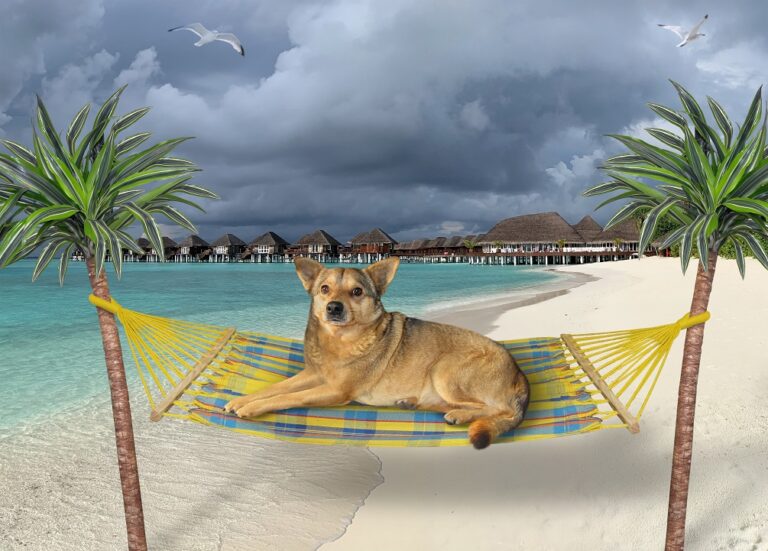

I am going on a two-month-long trip to Nepal, India, and Maldives. I would likely spend the most time in India and the least in the Maldives. I have a pet dog and I don’t like leaving him in someone else’s care at home. My dog fits all the requirements of different airlines and I have all the paperwork but I am unsure whether I could take my dog to these countries?

